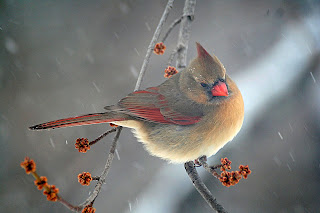
Everyday beauty: Watching the cardinals
(published 3-3-10)
Want to feel better about your car, especially if you drive a Toyota? Here’s my advice: Get a pair of those Illinois license plates with our state bird, the northern cardinal.
In December I finally took the plunge, plunking down $70.44 for the state’s “environmental” tags. Hopefully some of that money actually does some good. But I know this, my 2003 Corolla has never looked better. Recall my car if you must, just don’t mess with my plates!
The cardinal is an easy bird to like. John James Audubon, referring to the “cardinal grosbeak,” said it best: “In richness of plumage, elegance of motion, and strength of song, this species surpasses all its kindred in the United States.”
By sight and sound, we know this bird well. Cardinals are reliable backyard visitors and impossible not to notice. Since mid-February, on clear mornings, maybe you too have heard the males singing from high perches. Their loud, clear whistle is one of the best harbingers of spring.
Yet cardinals are so common, so expected, most of us take them for granted. For this column, I decided to learn more about them. Here are a dozen things about redbirds that perhaps you didn’t know:
1) The highest concentration of cardinals in the U.S. is thought to be in Louisiana and Mississippi, reflecting the fact that our “northern” cardinal was once a predominantly southern species. Northward range expansion began in the 1800s and accelerated in the 20th century.
2) Cardinals (or “Virginia nightingales”) were once commonly trapped in the south and sold as cage birds. Many were shipped to Europe.
3) Cardinals sing 8 to 10 different songs. A robin may sing 70!
4) Both males and females sing when nesting time approaches. Female cardinals sing from the nest when they’re hungry, so the male knows to bring her food. You may even hear a cardinal in the middle of the night—if you do, it’s probably a female.
5) The oldest cardinal on record lived 15 years. A typical life span is 2 or 3 years.
6) Cardinals generally stay put. They are non-migratory and may range only a few miles during their entire lifetimes.
7) Cardinals are loyal mates with strong pair bonds. This spring, watch for the so-called “courtship kiss” when a male passes a seed from his bill to the female’s bill.
8) Cardinals are attentive parents. Unfortunately they raise a lot of cowbirds, too. (The brown-headed cowbird lays its eggs in other species’ nests.)
9) Cardinal territories are typically 2 to 10 acres and males defend them aggressively. In winter, they are not as territorial and form feeding flocks.
10) A cardinal’s foremost food and nest site competitor is the gray catbird.
11) Juvenile cardinals have dark bills and a plain face (no black mask).
12) The female cardinal has a country music theme song: “She Don’t Know She’s Beautiful,” by Sammy Kershaw.
OK, I made that last one up. But please make a point to examine the female closely, from head to tail. The beauty of her subtle coloration is undeniable.
Naturally the flaming-red male gets all the attention. And small wonder the cardinal is the most popular state bird by far. Kentucky adopted it in 1926, and six more states followed.
Ohio is a cardinal state too, but I possess a cherished piece of birding memorabilia that claims otherwise. A few years ago, during a stop along the turnpike, my son and I paused at one of those machines that press an image onto a penny. Jay has a collection of flattened coins stamped with places we’ve been or things we’ve seen (he loves turning the crank). At this particular machine near Toledo, one of the imprint options was “Ohio State Bird: Black-Crowned Night Heron.” Say what? Does the governor know about this? I love night herons, but I’m quite sure the species was never a Buckeye State icon!
For Ohio, Illinois and the other states, the northern cardinal was a good choice. The species deserves our admiration. And like many other common birds, it merits closer observation. Let’s watch our cardinals more carefully, and listen to their calls and songs with a keener ear. For birders of every ability level, cardinals offer one of the most conspicuous backyard learning opportunities around.
Copyright 2010 by Jeff Reiter. All rights reserved.
Female cardinal photo by Lori Indovina-Valus